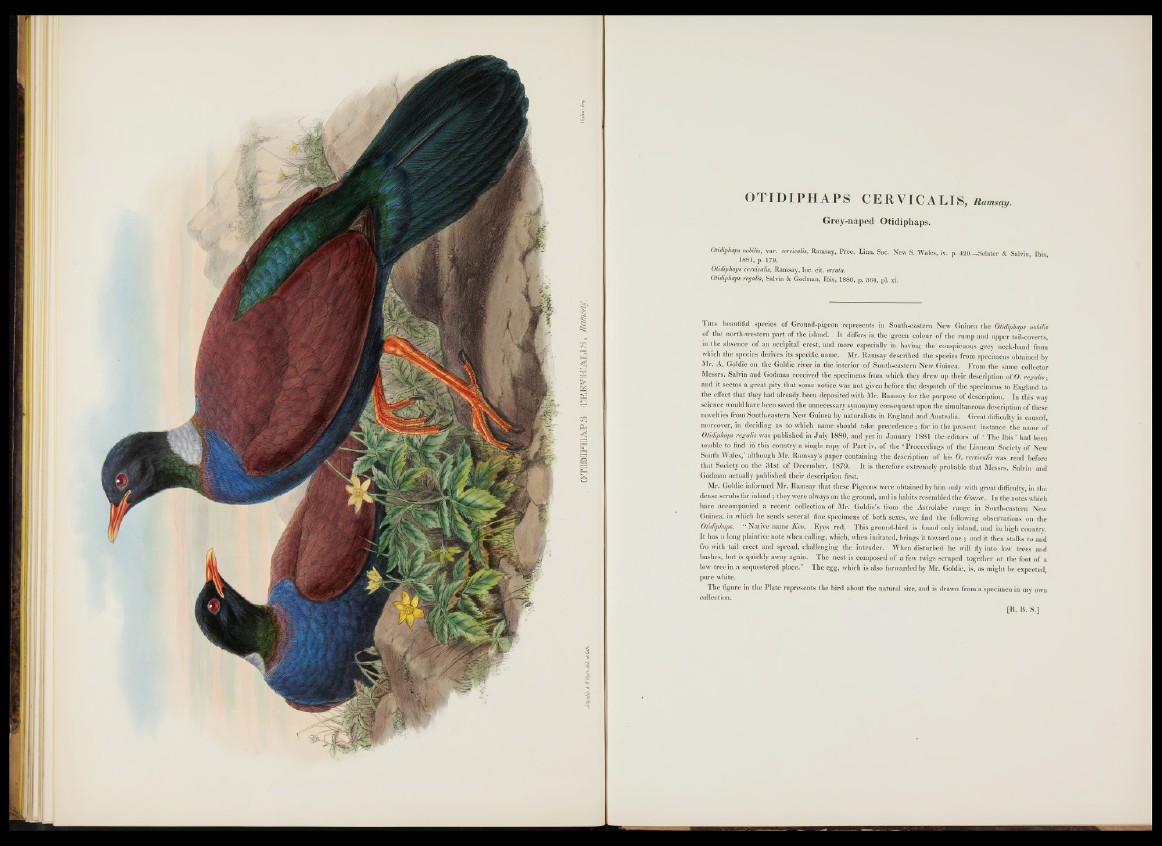
OTEMPHAPS CEKVICALIS,, R am say.
OTIDIPHAPS CERVICALIS, Ramsay.
Grey-naped Otidiphaps.
Otìdiphaps nobilìs, var. cervicalij, Ramsay, Proc. Lian. Soc. New S. Wales, iv. p. 420.—Sclater & Salvin Ibis
1881, p. 179.
Otidiphaps cervicalis, Ramsay, loc. cit. errata.
Otidiphaps regalis, Salvin & Godman, Ibis, 1880, p. 364, pi. xi.
T his beautiful species o f Ground-pigeon represents in South-eastern New Guinea the Otidiphaps tmbilis
o f the north-western p a rt o f the island. It differs in the green colour o f the rump and upper tail-coverts,
ip the absence o f an occipital crest, and more especially in having the conspicuous grey neck-band from
which the species derives its specific name. Mr. Ramsay described the species from specimens obtained by
Mr. A. Goldie on the Goldie river in the interior o f South-eastern New Guinea. From the same collector
Messrs. Salvin and Godman received the specimens from which they drew up their description o f 0 . regalis;
and it seems a great pity th at some notice was not given before the despatch o f the specimens to England to
the effect that they had already been deposited with Mr. Ramsay for the purpose o f description. In this way
science would have been saved the unnecessary synonymy consequent upon the simultaneous description o f these
novelties from South-eastern New Guinea by naturalists in England and Australia. Great difficulty is caused,
moreover, in deciding as to which name should take p reced en ce; for in the present instance the name o f
Otidiphaps regalis was published in Ju ly 1880, and yet in January 1881 the editors o f ‘ The Ibis ’ had been
unable to find in this country a single copy o f P a rt iv. o f the ‘ P roceedings o f the Linnean Society o f New
South W a le s / although Mr. Ramsay’s paper containing the description o f his 0 . cervicalis was read before
th at Society on the 31 st o f December, 1879. I t is therefore extremely probable th at Messrs. Salvin and
Godman actually published their description first.
Mr. Goldie informed Mr. Ramsay th at these Pigeons were obtained by him only with g rea t difficulty, in the
dense scrubs far in lan d ; they were always on the g round, and in habits resembled the Gouraj. In the notes which
have accompanied a recent collection o f Mr. Goldie’s from the Astrolabe range in South-eastern New
Guinea, in which he sends several fine specimens o f both sexes, we find the following observations on the
Otidiphaps. “ Native name Keo. Eyes red. This ground-bird is found only inland, and in high country.
I t has a long plaintive note when calling, which, when imitated, brings it toward one ; and it then stalks to and
fro with tail erect and spread, challenging the intruder. When disturbed he will fly into low trees and
bushes, but is quickly away again. The nest is composed o f a few twigs scraped together at the foot o f a
low tree in a sequestered place.” The egg, which is also forwarded by Mr. Goldie, is, as might be expected,
pure white.
T h e figure in the Plate represents the bird about the natural size, and is drawn from a specimen in my own
collection.
[R. B. S.]